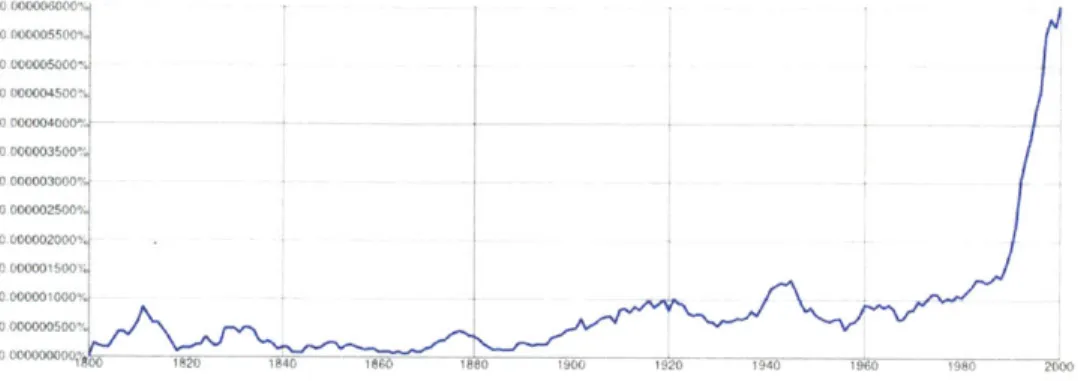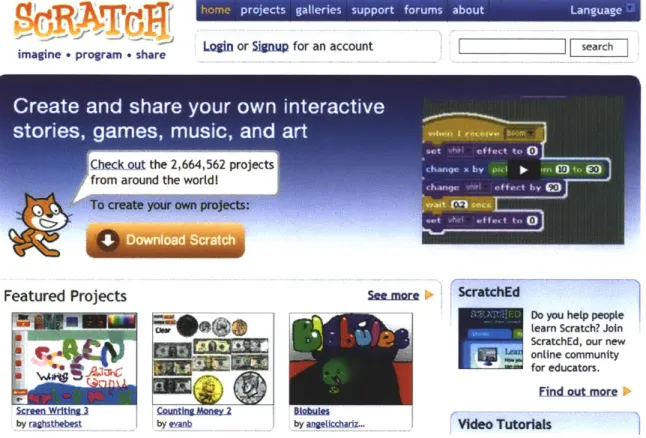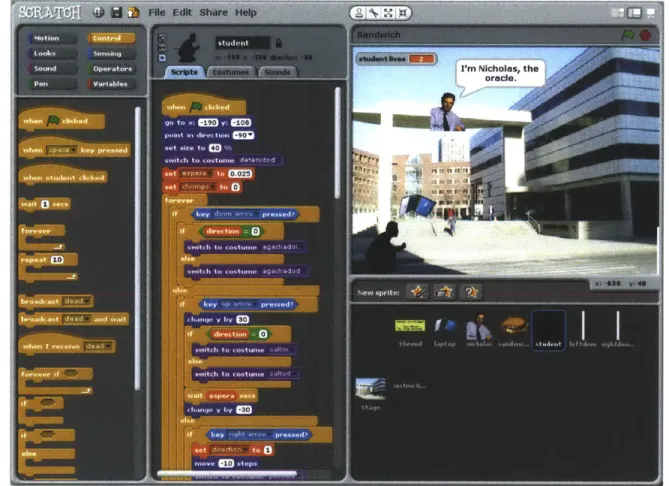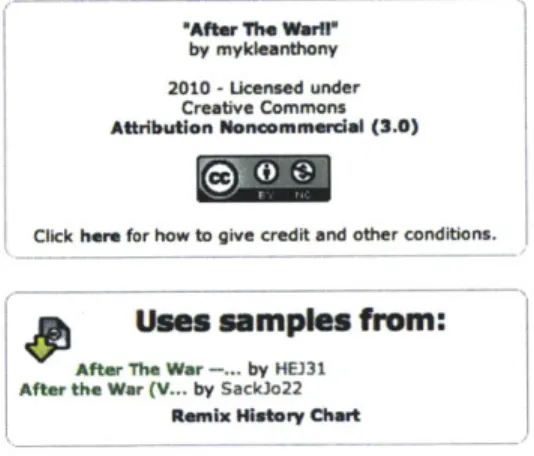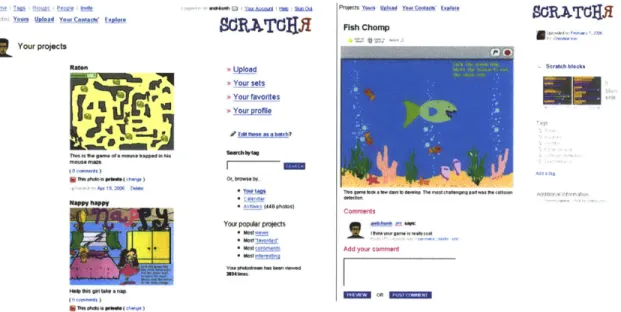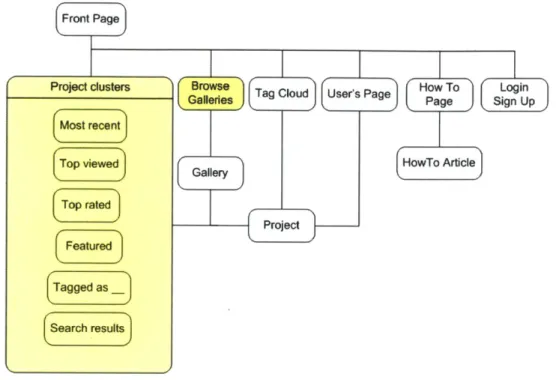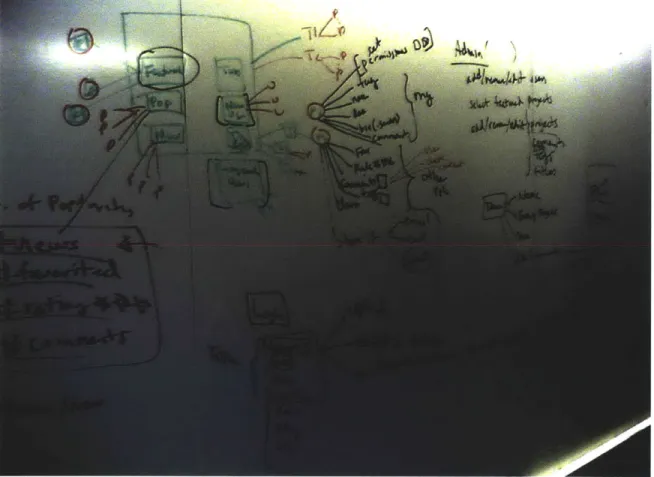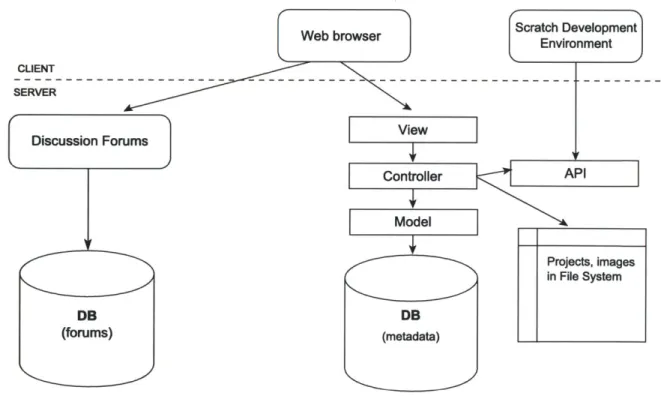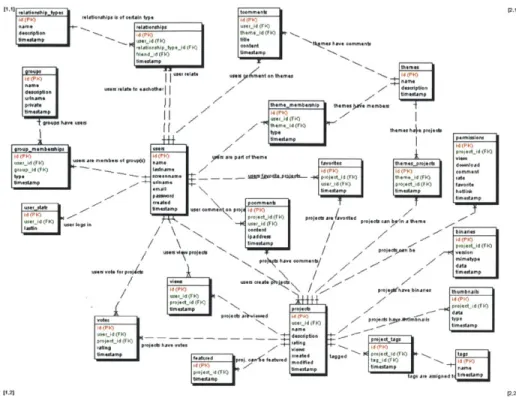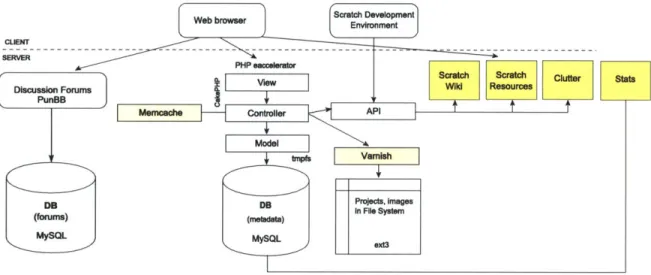Designing for Remixing:
Supporting an Online Community of Amateur Creators
by
Andres Monroy-Hernindez
S.M., Media Arts and Sciences, Massachusetts Institute of Technology (2007)
B.S., Electronic Systems Engineering, Tecnol6gico de Monterrey (2001)
Submitted to the Program in Media Arts and Sciences,
School of Architecture and Planning,
in partial fulfillment of the requirements for the degree of
Doctor of Philosophy in Media Arts and Sciences
at the
MASSACHUSETTS INSTITUTE OF TECHNOLOGY
~S NTITUTE
-"~
September 2012
8 This work is licensed under a Creative Commons Attribution 3.0 Unported
License.
The author hereby grants to MIT permission to reproduce and distribute publicly
paper and electronic copies of this thesis document in whole or in part.
Author
Certified by
Program i
Ied1A Arts and Sciences
August 20, 2012
Mitchel Resnick
LEGO Papert Professor of Learning Research
Program in Media Arts and Sciences
Thesis Supervisor
Accepted by
Patricia Maes
Associate Academic Head
Program in Media Arts and Sciences
Designing for Remixing:
Supporting an Online Community of Amateur Creators
by
Andres Monroy-Hernandez
Submitted to the Program in Media Arts and Sciences, School of Architecture and Planning,
on August 20, 2012, in partial fulfillment of the requirements for the degree of
Doctor of Philosophy in Media Arts and Sciences
Abstract
This work describes a framework for the design and study of an online community of amateur creators. I focus on remixing as the lens to understand the contexts and processes of creative expression as it is fostered within social media environments. I am motivated by three broad questions:
1) Process: how do people remix and what is the role of remixing in cultural production
and social learning?
2) Conditions: what kind of attributes influence people's remixing practices?
3) Attitudes: what are people's attitudes toward remixing?
As part of this work, I conceived, developed and studied the Scratch Online Community: a website where young people share and remix their own video games and animations, as well as those of their peers. In five years, the community has grown to more than one million registered members and two million community-contributed projects.
In the spirit of the theme of this work, this dissertation remixes several articles and blog posts written by myself or in collaboration with others. Wherever possible, the sources of the material are noted.
Thesis Supervisor: Mitchel Resnick
Title: LEGO Papert Professor of Learning Research, Program in Media Arts and Sci-ences
Designing for Remixing:
Supporting an Online Community of Amateur Creators
by
Andr6s Monroy-Hernindez The following people will serve as readers for this thesis:
Thesis Reader
Yochai Be ler
erkman Professor of Entrepreneurial Legal Studies Harvard University
Thesis Reader.
Robert C. Miller Associate Professor of Electrical Engineering and Computer Science MIT Computer Science and Artificial Intelligence Laboratory
Acknowledgments
First I want to thank my advisor, Mitchel Resnick, for the opportunity to be part of this ad-venture, and for welcoming me into the Lifelong Kindergarten family. His wisdom, patience, and constant support made my time at the Media Lab one of the greatest experiences of my life.
I also want to thank my dissertation and my qualifying exams committee for helping me expand my disciplinary horizons. Yochai Benkler's cooperation group at the Berkman Center opened my eyes to a wide range of disciplines. Rob Miller's group at CSAIL and his students helped me venture into the field of Social Computing. Tim Berners-Lee helped me understand the spirit behind the Semantic Web.
Much of the work on this document was only possible because of the ideas, contribu-tions, and support from several collaborators including Benjamin Mako Hill, Cecilia Aragon, danah boyd, Diana Aragon, Jazmin Gonzalez-Rivero, Jeff Nickerson, Kristina Olson, and Oshani Seneviratne.
The Scratch project is a group effort from the staff, the graduate, and undergraduate students at the Lifelong Kindergarten group, including Amos Blanton, Amon Millner, Brian Silverman, Chinua Shaw, Chris Garrity, Claudia Urrea, Eric Rosenbaum, Evelyn Eastmond, Han Xu, Gaia Carini, Jay Silver, John Maloney, Karen Brennan, Lance Vikaros, Leo Burd, Lis Sylvan, Michelle Chung, Mitchel Resnick, Natalie Rusk, Nick Bushak, Oren Zuckerman, Paula Bonti, Paul Medlock-Walton, Rachel Garber, Ricarose Roque, Rita Chen, Sayamindu Dasgupta, Stephanie Gayle, Tamara Stern, and Ubong Ukoh.
I also want to acknowledge the technical support I received from Anupom Syam, Anant
Seethalakshmi, Ashok Kumar, Kemie Guaida, and Vladimir Vuksan; and the community-management help from Mark Goff and Franchette Viloria.
Last but not least, I want to thank the four most important people in my life: Kristina, Andrea, mama y papa.
Contents
Abstract Acknowledgments Front Matter Contents . . . .. . . . . List of Figures ... List of Tables ... 1 Introduction1.1 Structure and Contributions of this Work
1.2 1.3
1.4
1.5 1.6
Economic and Cultural Production Software Engineering . . . . Learning and New Media Literacy Ethical and Legal Challenges . . .
Social Computing System Design .
2 Remixing Systems 2.1 V ideo . . . . ... .. .. .. . . 2.2 Im ages ... 2.3 Audio . ... . . 2.4 Status Updates ... 2.5 Source Code ... 2.6 Programmable Media . . . . 2.7 Summary . . . .
3 The Scratch Online Community 3.1 Infrastructure Development . . .
3.1.1 Ideation . . . .
3.1.2 User Experience . . . . . 3.1.3 Architecture . . . .
3.1.4 Sharing from the Desktop
3.1.5 Scale . . . . 3.2 Participation Patterns . . . . 3.2.1 Project making . . . . 3 5 6 6 9 12 13 15 18 19 20 21 22 24 24 27 29 31 32 33 36 37 . . . . 3 8 . . . . 3 8 . . . . 4 0 . . . . 4 5 . . . . 5 3 . . . . 5 4 . . . . 6 0 . . . . 6 5
3.2.2 Interactions . . . . .. . . . . 72
3.3 Discussion . . . . 72
3.3.1 Learning through Online Community . . . . 77
3.3.2 Sharing and collaboration . . . . 78
4 Process of remixing 80 4.1 Case Studies . . . .. . . . . 81
4.1.1 M esh Inc's collaboration . . . . 81
4.1.2 Jumping M onkey's ripple effect . . . . 83
4.1.3 Galaxyman's "media franchise" . . . . 84
4.2 Taxonomy . . . . 88
4.2.1 Originality . . . . 88
4.2.2 Generativity . . . . 91
4.2.3 M easures . . . . 94
5 Conditions for Remixing 100 5.1 System Attributes . . . . 100 5.1.1 M odularity . . . . 101 5.1.2 Attributability . . . . 104 5.1.3 Openness . . . . 104 5.2 Content Attributes . . . . 105 5.2.1 Generativity . . . . 106 5.2.2 Originality . . . . 107 5.2.3 Results . . . . 113 5.2.4 Limitations . . . . 116 5.3 Discussion . . . . 117
6 Attitudes toward Remixing 119 6.1 Study 1: How do people respond to remixing? . . . . 119
6.1.1 Procedure . . . .. . . . . 120
6.1.2 Results . . . . 120
6.1.3 Discussion . . . . 121
6.1.4 Implications for design . . . . 121
6.2 Study 2: When do creators accuse remixers of plagiarism? . . . . 121
6.2.1 Procedure . . . . 123
6.2.2 Results . . . . 124
6.2.3 Discussion . . . . 126
6.2.4 Implications for design . . . . 127
6.3 Study 3: Are plagiarism complaints more common when remixes are more similar? . . . . 127
6.3.1 Procedure . . . . 128
6.3.2 Results . . . . 128
6.3.3 Discussion . . . . 128
6.3.4 Implication for design . . . . 128
6.4.1 Study 4a: Automatic Attribution . . . . 130
6.4.2 Study 4b: Manual Crediting . . . . 131
6.5 Study 5: Interviews with participants . . . . 134
6.5.1 Methodology . . . . 134
6.6 D iscussion . . . . 139
7 Conclusions 142 7.1 Summary and Contributions. . . . . 143
7.2 Design Implications. . . . . 144
7.3 Future Research . . . .. 147
7.4 Epilogue: MusicalMoon . . . . 148
Appendix A Entity Relationship Diagrams 150 Appendix B Project Attribute Tables 154
List of Figures
1-1 Popularity of the term "remix" . . . . 14
1-2 The home page of the Scratch Online Community website . . . . 16
1-3 Scratch programming environment . . . . 17
1-4 Image macro mocking the recursive nature of remixing . . . . 19
2-1 Download button and license statement of a YouTube video . . . . 25
2-2 Remix button on YouTube . . . . 25
2-3 Credit-giving on Vimeo . . . .26
2-4 Jumpcut's web-based editor . . . . 27
2-5 License selection on Flickr . . . . 28
2-6 Distribution of Creative Commons licenses usage on Flickr . . . . 28
2-7 Selecting a Creative Commons license in DeviantArt. . . . . 29
2-8 Sharing options in DeviantArt. . . . . 29
2-9 Front page and online editor of OPENSTUDIO .. . . . . 30
2-10 ccMixter showing the Creative Commons license . . . . 30
2-11 IndabaMusic displaying the number of remixes of a music file. . . . . 31
2-12 The "retweet" button, automating attribution on Twitter. . . . . 31
2-13 Sharing a friend's post on Facebook, automatically attributed. . . . . 32
2-14 Sourceforge project page. . . . . 33
2-15 Forking graph on Github. . . . . 33
2-16 YTMND's front page. . . . . 34
2-17 Newgrounds' front page. . . . . 35
2-18 MyGame front page and page showing game edition (template). . . . . 35
2-19 Moose Crossing: play and scripting environments. . . . . 35
3-1 Scratch website (April 2006) . . . . 39
3-2 Mockup of Scratch website page based on Flickr (May 2006). . . . . 41
3-3 Mockup of interface for uploading a Scratch project (May 2006). . . . . 42
3-4 Site map outlining all the sections of the website (May 2006). . . . . 43
3-5 Whiteboard outlining the elements of the website (June 2006). . . . . 44
3-6 First prototype of Scratch website (June 2006) . . . . 45
3-7 Front page. . . . . 47
3-8 Project page. . . . . 48
3-9 Profile page (My Stuff). . . . . 49
3-11 Project-browsing page. . . . . 51
3-12 Three remixing visualizations. . . . . 52
3-13 Initial architecture of ScratchR. . . . . 52
3-14 Initial Entity Relationship Diagram of the ScratchR database (ca. 2007). 53 3-15 Five years of monthly pageview counts. . . . . 54
3-16 Scaled-up Architecture of ScratchR. . . . . 55
3-17 Flag word cloud . . . . 56
3-18 Community members can flag projects as "inappropriate". . . . . 57
3-19 Administrators can censor, demote, protect, or feature a project. . . . . 58
3-20 Administrators' control panel to deal with community-generated flags. . . . 59
3-21 World map showing cities with most number of Scratch visitors. . . . . 61
3-22 Distribution of ages of project sharers. . . . . 61
3-23 Distribution of projects by account age. . . . . 62
3-24 Project creator's age and account age monthly mean. . . . . 63
3-25 User age and account age monthly median (project creators only). . . . . . 64
3-26 Projects and creators per month. . . . . 65
3-27 Example of a Scratch script in visual and textual form. . . . . 66
3-28 Script cloud . . . . 67
3-29 Histogram of block usage . . . . 68
3-30 Im age cloud . . . . 70
3-31 Project complexity and user's and account's age. . . . . 71
3-32 Monthly mean number of interactions per project . . . . 74
3-33 Scratch users contribute to and learn from the online community. . . . . 79
4-1 BeepBop's sprites project. . . . . 82
4-2 Remixing events started by "Jumping Monkey" . . . . 85
4-3 Chocolate Bar episodic series. . . . . 87
4-4 Remixing taxonomy based on originality and generativity. . . . . 88
4-5 Inspirational rem ix . . . . . 89
4-6 Example of incremental remix. . . . . 90
4-7 Example of component-based remixing. . . . . 91
4-8 Sequence of iterations of a crowd-based remix. . . . . 93
4-9 Distribution of derivativeness. . . . . 95
4-10 The most remixed project created by a community member. . . . . 97
4-11 Maximum remix levels in remix chains . . . . 98
4-12 In-degree distribution . . . . 99
4-13 Map showing remixing connections. . . . . 99
5-1 Sociotechnical system attributes that facilitate remixing system . . . . 101
5-2 Anatomy of a Scratch project . . . . . 102
5-3 Use of the "textbox" sprite from Scratch Resources. . . . . 103
5-4 Visual representation of the hypotheses promoted in this section . . . . 109
5-5 Diagram of the relationship between originality and generativity . . . . 115
6-1 Distribution of reactions to remixing when automatic credit . . . . 131
6-3 Word cloud of comments to remixes . . . . 134
7-1 Pac-Man remix removed after to DMCA take down notice. . . . . 143
7-2 Instance of ScratchR for Portugal. . . . . 145
7-3 Scratch Online Community as seen by a 14-year-old community member. 146
A -1 U ser tables . . . . 151 A-2 Project tables . . . . 152 A-3 Project tables . . . . 153
List of Tables
3.1 Table of project attributes . . . . 73
5.1 Summary stats for variables used in analysis . . . . 111
5.2 Regression models for generativity and originality . . . . 114
6.1 Plagiarism accusations . . . . 122
6.2 Taxonomy of logistic regression models on accuse.plag . . . . 124
6.3 Table listing details of interviewees used in Study 2. (n = 12) . . . . 135
B.1 All Projects: Male . . . . 155
B.2 All Projects: Female . . . . 156
B.3 Remixes: Male and Female . . . . 157
B.4 Remixes: Male . . . . 158
B.5 Remixes: Female . . . . 159
B.6 De Novo projects: Male and Female . . . . 160
B.7 De Novo projects: Male . . . . 161
B.8 De Novo projects: Female . . . . 162
B.9 Only Collaborative Remixes: Male and Female . . . . 163
B.10 Only Collaborative Remixes: Male . . . . 164
B.11 Only Collaborative Remixes: Female . . . . 165
B.12 Only Versioning Remixes: Male and Female . . . . 166
B.13 Only Versioning Remixes: Male . . . . 167
Chapter 1
Introduction
We are like dwarfs standing
upon
the shoulders of giants, and so able to seemore and see farther than the ancients.
-Bernard of Chartres, circa 1130
A dwarf on a giant's shoulders sees farther of the two.
-George Herbert, 1651
If I have seen further it is by standing on the shoulders of giants.
-Isaac Newton, 1676
Digital networked technologies are challenging the romantic notions of what it means to be a creator. Today's creators sample, remake, fork, mash-up, collage, and appropriate. They remix. For example, Wikipedia editors frequently tweak existing articles, computer programmers on GitHub often fork existing source code repositories, social media users on Twitter or Facebook regularly retweet or share other people's status updates, and even designers of physical objects on Instructables reuse existing blueprints or build on others' work. The digital artifacts of the social web are often the result of remixing.
Today the term remixing refers to the act of creating something new based on existing ma-terials. Even before digital technology started to be used for creative expression, "remixing" described the mechanical process of combining physical source materials, something often used in fields like agriculture, chemistry, and manufacturing. For example, one of the first uses of the word remixing that I found' was in an 1839 gardening magazine describing the recombination of soils (Loudon, 1839). As digital music machines started to become more common, the term started to appear in this context. For example, the 1966 edition of a popular magazine for high fidelity audio devices described how remixing was originally used to create backups of tapes: "remixing began, historically, as a protective measure," then it became "the final step in making a record" (Davis, 1966). By the late 1970s, remixing was
a prominent part of the music scene, and by the end of the century exploded in popularity
(see Figure 1-1). Presumably, this resulted from the adoption of digital technologies that opened new forms of creative expression.
U 00 000N11
0 00000300X
o 00 40 40 188~140 00 1 000 1120 1(40 _10 100 20
Figure 1-1: Popularity of the term "remix" based on word frequency (from Google NGram). Although content reuse predates digital technologies, the advent of these tools has made remixing ubiquitous, more visible, and more derivational. The ubiquitousness of remixing comes from the extensive range of media and communities that have embraced this practice, from video, to text, to music, to code, to photographs, to CAD blueprints, among others. Today, "anybody can remix anything [. . .] and distribute it globally pretty much instantly" (Ferguson, 2010). In addition, remixing is more visible than before because, as with other activities that leave a digital trace, it can be captured and measured through computational means. For example, YouTube can detect when a video reuses an existing song, and displays this on the video's web page. Last, remixes are more derivational because computers are, in essence, copying machines that allow creators to reuse verbatim and almost infinitely the bytes of the source materials, something impossible in the analog world. The term remixing is possibly a fad, but what it represents -the concept of digital reuse- has far-reaching and long-lasting implications. The rise of remixing embodies a significant shift in the way cultural and economic production work.
Remixing is not without controversy. As early as 1979, an article in Billboard magazine described the tensions around remixing between DJs and music producers: "The sparks started flying at the Disco VI international producers panel when Arista's Audrey Joseph challenged those producers who won't let DJs remix their records" (Media, 1979). By the year 2001, the controversy was no longer whether music producers would allow remixing, but how to handle the increased popularity of remixes. The magazine best known for its music popularity charts made the decision to stop counting the popularity of a remix toward the popularity of the song on which it is based on. Billboard made this decision because of the case of a particular remix gaining more popularity than the original song. The controversy forced the magazine to issue the following statement:
[T]he enormous growth of 'Real' [the "original" song] largely comes from a re-worked version of the song featuring Ja Rule [the remixer. The Ja Rule version soon became the track of choice at all formats, so we have now added Ja Rule's name to the [... ] charts. For the current chart week, 85% of the song's audience comes from the remix version (Pietrolungo, 2001).
This incident arguably marked the coming of age for remixing. Today, such debates continue and are even more visible.
This work focuses on these challenges and others brought up by remixing, with an emphasis on implications for the design of social, technical, and learning systems. Remixing defies the traditional models and assumptions of authorship and creativity. Its prominence also has deep implications for the design of sociotechnical and learning systems. In this dissertation
I focus on the design of a particular system, a website, built to foster creative collaboration
through remixing. As the person leading the construction of this website and the community that grew from it, I narrate the "behind the scenes" story from its start until its five-year anniversary. Then, I focus on examining what people did on this system; in particular, I examine how people engage in remixing, what makes remixing thrive, and the attitudes
people have toward it.
The empirical setting for this work is the Scratch Online Community, a website (see Figure 1-2) I conceived and developed over the past five years in collaboration with others at the Lifelong Kindergarten research group. The website allows anyone, especially young people between eight and sixteen, to share their animated stories, interactive art, and video games. Participants use the Scratch development environment, a desktop application (see Figure
1-3), to create or remix projects by putting together images, music and sounds with visual
programming blocks that control their behavior (Resnick et al., 2009). Scratch and its website enable young people to express themselves creatively, gain new media literacy skills, and learn core computational thinking concepts, all in a community of peers.
1.1
Structure and Contributions of this Work
In this introductory chapter, I provide an overview of the remixing phenomenon, its history, and the reasons why it is an area worthy of study. I do this by presenting the theoretical background that frames the discussions and analyses of the rest of this work.
The second chapter presents an overview of the state of the remix culture on the social Web. I examine the remixing-related features of popular social computing systems that have influenced directly or indirectly the design of the Scratch Online Community.
The third chapter is a design brief of the Scratch Online Community. In that chapter, I answer the question of what an online remixing community looks like from the inside. The chapter describes the design of the sociotechnical infrastructure of the Scratch website, and how people used it over the course of five years.
The fourth chapter centers on the question of how people remix. This chapter examines the
process of remixing by introducing a remixing taxonomy across two dimensions: originality
and generativity. Then I focus on a few case studies that use the taxonomy to examine remixing in different forms of collaborative work.
The fifth chapter concentrates on the question of what influences remixing. In this chapter,
I investigate what conditions are conducive to remixing. First, I reason through what I
Login or Signup for an account
imagine * program * share
Featured Projects
... Do you help people
learn Scratch? Join ScratchEd, our new ontine community
We
for educators.Find out more> Screen Writing 3 1Counting Monevj 2 Iobue
yragshebest byean,,, .by attima Video Tutorials
Figure 1-2: The home page of the Scratch Online Community website http:// scratch.mit.edu (July 2012).
projects galleries support forums about Language
06R
Don§dSRatc
Figure 1-3: Scratch programming environment (version 1.4). The leftmost column repre-sents an inventory of possible "programming blocks" which are assembled into program code in the center column. The area in the top right represents the project as it will be displayed to a user interacting with the finished product. The bottom right column shows the available sprites which are controlled by the code.
in-depth study of how the conditions under which Scratch projects are created influences remixes' originality and generativity.
In the sixth chapter, I examine people's attitudes toward remixing. This chapter investigates
how people react to remixing. In particular, I focus on the perspective of young people as
creators of artifacts that are remixed in the Scratch Online Community, rather than only focusing on youth as remixers as much of the literature does.
The concluding chapter summarizes the four main contributions of this work: the creation of a working social computing system, the development of a one-million-member online community, the collection of a rich research data set of user interactions, and a framework to understand remixing based on a set of mixed-methods studies. This chapter also provides directions for future research.
This work relies primarily on quantitative and qualitative analyses of the Scratch Online Community. I base my findings and rhetorical arguments on interviews, case studies, exper-iments, statistical and network analyses. The quantitative analyses examine a large corpus of five years of log data from that includes more than one of million registered accounts, close to ten million comments, and two million interactive media objects. In addition, many findings are based and motivated by my personal experience as designer and participant of the Scratch Online Community from its start until its five-year anniversary.
In the spirit of remixing, this introductory chapter and the dissertation as a whole reuse several coauthored articles, blog posts, and unpublished write-ups created during the past few years by myself and many collaborators. I will indicate whenever possible the exact source of the text. Often, I have modified the original text to fit the structure of this document better. All errors are my own, and do not reflect my collaborators' efforts.
1.2
Economic and Cultural Production
Network information technologies have facilitated the emergence of social production as an alternative to markets and firms in what is known as commons-based peer production (Benkler, 2002). Many of today's products, services, and cultural icons are the result of peer-produced innovations (von Hippel, 2005). From the software that we find in our devices to the content we consume on sites like YouTube. The cultural practices have changed, and the boundaries between production and consumption have blurred (Bruns, 2007). These commons-based peer "prod-users" need access to the work of others for them to remix and share back the derivatives.
These creative activities, based on the idea of building new things by combining existing ones, are not new. For a long time artists have engaged in similar practices through "appro-priation art", "pastiche", "collage", "sampling" and "bricolage". Furthermore, folk culture and oral traditions rely on the idea of remixing what others have made. As Manovich (2005) argues, ancient Rome was a remix of ancient Greece, exemplifying how remixing is part of cultural evolution. Similarly, Jenkins (2006) describes how remixing has been part of art practice for a long time:
[T]he story of American arts in the 19th century might be told in terms of the mixing, matching, and merging of folk traditions taken from various indigenous and immigrant populations.
Despite this common feeling that everything old is new again, the influence digital tech-nologies have had in remixing practices is self-evident. Manovich (2005) has called remixing "a built-in feature of the digital networked media universe," while Sinnreich et al. (2009) argues that these technologies have enabled people to create perfect copies and remix the source materials themselves rather than just being inspired by them. Jenkins (2007) argues that
it was the emergence of participatory cultures of all kinds over the past several decades that has paved the way for the early embrace, quick adoption, and diverse use of platforms like YouTube.
Not surprisingly, Internet culture is particularly amenable to remixing. The popular "image macros" for example are images that get remixed ad nauseam (see Figure 1-4). Users of influential websites like 4chan often refer to having a special folder on their computers where "they preserve images for future enjoyment or remixing" (Bernstein et al., 2011). As early as 2005, a survey of online US teenagers (Lenhart and Madden, 2005) found that more than half (57%) of them had created content "for the Internet," of those, one-fifth (19%) reported being "content remixers" -slightly more than adults (18%). The survey found remixing to be "equally prevalent across genders, ages, and socioeconomic groups."
Figure 1-4: Image macro mocking the recursive nature of remixing. The image itself is a remix of an image taken from a video of the rap artist "Xzbit." (Quickmeme, 2011)
1.3
Software Engineering
Software is born digital so remixing is inherent in the way it develops. Engineers constantly try to devise ways of avoiding the duplication of efforts, "Good programmers know what to
YO DAWG,
I
HEARD YOU
IlKE
REMIKES
SO I PUT A REMIX IN YOUR REMIX SO
YOU CAN R EMIX WHILE YOU R EMIX
write. Great ones know what to rewrite (and reuse)" Raymond (1999). Furthermore, two of the tenets of Free and Open Source Software are precisely the ability to remix and the opposition to any restrictions of this freedom:
Creativity can be a social contribution, but only insofar as society is free to use the results. If programmers deserve to be rewarded for creating innovative programs, by the same token they deserve to be punished if they restrict the use
of these programs (Stallman, 1985).
Even proprietary software firms, those who put restrictions on the use of computer programs, encourage in-house remixing. Software engineers have a long history of studying code remixing or reuse, primarily with the goals of improving productivity and quality (Frakes and Terry, 1996). For example, they have developed quantitative measures for remixing, such as the model of software reuse based on Gaffney Jr and Durek (1989), that calculates the "amount of reuse" using the lines of code as the unit of analysis (Frakes and Terry,
1996).
lines of reused code in system or module
amount of reuse =
total lines of code in system or module
This more formal approach to remixing is component-based software engineering, a discipline concerned with
designing components and libraries to be reusable as-is, identifying and isolat-ing reusable components from an existisolat-ing code base, and makisolat-ing a searchable
repository of components (Philip et al., 2012).
This discipline is based on the use of well-documented libraries, modules, and API's2, leading to what it is known as "service-oriented computing" (Papazoglou and Georgakopoulos, 2003).
The second approach, called "opportunistic programming", means the type of software development "with little to no upfront planning about implementation details," where "ease and speed of development are prioritized over code robustness and maintainability" (Brandt et al., 2008). This type of programming relies on "existing source code that was not specially packaged for reuse" (Philip et al., 2012), such as copying-and-pasting (Kim et al., 2004) from tutorials, discussion forums, emails, and Q&A websites.
1.4
Learning and New Media Literacy
The remix literacy observed among software developers is also widely popular in informal learning environments (Perkel, 2008). Cultural anthropologists and media scholars have documented how young people engage in creative practices through remixing. For example, Ito (2007) has described how children relate to media franchises such as Pokemon by "col-lecting their own set of cards and virtual monsters and combining them into a deck or battle
2
team that reflects a unique style of play," showing how they can "master highly esoteric content, customization, connoisseurship, remixing." Similarly, Jenkins (2006) has narrated how children have become active participants in media creation by remixing their favorite literary characters, such as the Harry Potter fan fiction communities he has studied.
These observations have motivated scholars to argue that remixing is a necessary skill to succeed in today's society. For example, Jenkins et al. (2009) argues that "appropriation" is one of the core literacy skills for the 21st century, which he defines as the "ability to meaningfully sample and remix media content." Jenkins proposes to support remixing by asking students to, for example,
work in teams to think through what would be involved in transforming an exist-ing media property (a book, film, television series, or comic book) into a video or computer game.
Livingstone (2008) has described similar practices when studying Internet use but also presents the challenges that these creative practices, such as legal and ethical issues, have to handle.
Even before remixing was popular, experts had argued the importance of providing learners access to social environments with common resources on which to build. For example, Wenger (1998) stressed the importance of having access to a "shared repertoire of communal resources" to help shape a "community of practice." Similarly, Bruckman (1998) argued that building on previous works "encourages people that they can and would like to make something of their own," advocating for systems where "every object in the system functions as a possible model to learn from and be inspired by."
Building on the idea of Constructionism - a learning philosophy based on the idea that some of the most valuable learning experiences occur when people engage in building per-sonally meaningful objects in apprenticeships (Papert, 1980) - Turkle and Papert (1990) advocated learning through remixing or "bricolage," where learners construct by "arrang-ing and rearrang"arrang-ing
[...]
a set of well-known materials," rather than planning before time what they want to create. Similarly, Situated Learning advocates for legitimizing peripheral forms of participation, in particular through socialization, visualization, and imitation in apprenticeship-like learning environments (Lave and Wenger, 1991) that support the spirit of remixing.1.5
Ethical and Legal Challenges
Although remixing opens new possibilities for learning, economic, and cultural production, it is also morally and legally contested. Judge Posner (2007) has articulated that plagiarism is highly context-dependent and that one can assess the ethics of appropriation by thinking through the lens of deception, perception, and social expectation. For a more grounded
analysis, take the following three examples and the questions they pose.
9 The creator of one of the most popular Harry Potter fan fiction community websites,
rights to the book and the movie. Eventually the company dropped the legal action and reached an agreement (Jenkins, 2006). What should young people's rights and responsibilities be when remixing?
9 A federal court judge determined that photographer Richard Price violated copyright
law for creating a type of appropriation art that consisted of taking pictures of the famous Marlboro cowboy advertisements and printing them in a large format (Batts,
2011). What role does originality play in remixing?
e Partly because of the Digital Millennium Copyright Act, YouTube had to implement
a system for automatic detection of remixing of copyrighted content. This led to 5% of YouTube videos being removed for copyright infringement (Cha et al., 2007). How
should automated systems handle remixing?
Examples like these prompted Lessig (2008) to argue that "copyright extremism" "chills" innovation and creativity, especially among young people who often engage in these prac-tices. Similarly, Benkler (2006) argues that if we want peer-production to flourish, we must figure out how to enable remixing:
If we are to make this culture our own, render it legible, and make it into a new platform for our needs and conversations today, we must find a way to cut, paste, and remix present culture. It is precisely this freedom that most directly challenges the laws written for the twentieth-century technology, economy, and cultural practice.
Such arguments led to the development of the Creative Commons, which, among other things, provide a set of human and machine-readable licenses that empower creators to have more control of their copyright and encourage them to release their work legally under more permissive licenses that foster amateur creativity.
At the core of examining the ethics of remixing lies the understanding of cooperation -how much people are willing to sacrifice their selfish and rational desires to obtain monetary and reputational gains, or to behave in altruistic and cooperative ways, which are the foundations of my work.
1.6
Social Computing System Design
YouTube's automation example highlights one of Lessig's important contributions to system design: "code is law" (Lessig, 2000). As I developed the Scratch website, one of the biggest challenges was to decide what features to implement. Examining other systems that support collaborative online creativity helped in the design of the website. This came from both my own experiences interacting with many websites as well as human-computer interaction research, more specifically the field of computer-supported collaborative work.
Wikipedia has been perhaps the most widely researched collaborative system. For example, Viegas et al. (2004) developed a visualization of Wikipedia edits that led to insights into the nature of the system and its editors' ability to collaborate. Later Kittur and Kraut (2008)
studied the quality of Wikipedia's articles in relationship to various types of coordination mechanisms.
Similarly, analyses of open-source software development have led to insights into the mech-anisms that lead to successful cooperative projects. Raymond (1999), for example, argued that one of the lessons to be learned from open-source software programmers is the impor-tance of knowing what to rewrite and reuse. He describes how Linus Torvalds (the creator of Linux) did not "try to write Linux from scratch" instead "he started by reusing code and ideas from Minix, a tiny Unix-like OS for PC clones."
Researchers have also developed web mash-up tools that allow people to remix web content (Bolin et al., 2005; Wong and Hong, 2007). A study on one of those tools found that despite many of its users lacking programming skills, the tools were an effective way of searching and aggregating information (Zang and Rosson, 2008).
More specifically on online communities for remixing, Shaw and Schmitz (2006) developed a video remixing platform and studied the nature of the generative video segments intend-ing to understand how to integrate automatic recommendation systems with user-driven suggestions. Similarly, Diakopoulos et al. (2007) analyzed users' participation in a video remixing website and documented how participants developed specific norms for appropri-ating other's work that were not encoded in the architecture of the website.
Additionally, a study of the music remixing online community ccMixter looked at the impact of a remixing contest in the community dynamics. The study found that the-contests increased participation among newcomers but that they did not continue using the website after the contest (Cheliotis and Yew, 2009).
Chapter 2
Remixing Systems
The idea was that anybody who used the web would have a space where they could write and so the first browser was an editor, it was a writer as well as a reader. Every person who used the web had the ability to write something.
-Tim Berners-Lee, 2005
When I started developing the website for the Scratch Online Community, I looked around for similar systems to get inspiration. "Web 2.0" was in full swing. YouTube was less than two years old, and Flickr was close to three; both were gaining popularity but were not nearly as big as now. Those systems I examined influenced the design decisions that went into creating the Scratch website. In this chapter1, I list some of these systems and briefly examine how they approached remixing. This survey includes websites for sharing and remixing videos, images, audio, status updates, and programmable media. This list is not intended to be comprehensive, or to go into detail. My goal here is to give an overview of the state of remixing on the Web while the Scratch website was in development. In addition, my goal is to help frame subsequent analyses in the ecosystem of remixing systems.
2.1
Video
YouTube2 is the largest video sharing website (Cha et al., 2007), acting as a host for a combination of amateur and professional content since 2005. It has become the quintessen-tial media-sharing website, and, therefore, it has become a common target of copyright and licensing disagreements related to remixing. For example, the deletion from YouTube of a popular video of a baby dancing to one of Prince's songs caused great controversy, and highlighted how copyright laws might stifle amateur creativity (Lessig, 2008). Since early
Based on a co-authored poster paper with Oshani Seneviratne titled "Remix Culture on the Web: A Survey of Content Reuse on Different User-Generated Content Websites" available in Proceedings of Web Science 2010
Favorite -Share Pnylasts Flag * Download
Downead thi video for Me viewbin.
LICENSE: Creative Commons (Attribution-Noncommercial-No Derivative Works). L Doo High Quality MP4 Leam more
Figure 2-1: Download button and license statement of a YouTube video (2010).
2009, YouTube started to allow special "partners" to display a download button3 and se-lect the license for their videos (Tran, 2009), (see Figure 2-1). The licensing options were "personal," "public domain," and the various Creative Commons licenses. Partners had to be approved, however. Users could apply to become partners and YouTube would make a decision based on the size of the applicant's audience (based on the popularity of their existing videos), among other metrics (YouTube, 2010). Originally, partners were primarily government entities (like the White House), universities, and other nonprofit organizations.
Music labels and other companies joined later.
Today, anyone can publish his or her YouTube videos under a Creative Commons license, which enables a "remix" button under the video (see Figure 2-2). Clicking this button opens the video in a web-based editor allowing people to create derivatives right on their
browser.
YouTube, under much pressure from copyright holders, implemented the first version of their content identification system on June 2007. This system allowed copyright holders to automatically identify remixes of their materials and decide to block the remix (sending a copyright infringement notice to the remixer), gather metrics of its popularity, or monetize from it by sharing some advertising revenue (Chen, 2007). Shortly after this system was put in place, 5% of all videos were deleted because of copyright infringement (Cha et al., 2007), including videos that had purchased the rights to use the materials. People whose remixes were taken down could file a complaint through YouTube's legal department.
Figure 2-2: Remix button on YouTube (2012).
YouTube users who want to explicitly give credit or link to the source materials have repurposed the description and the "video reply" feature. The first consists of using the description of the video to reference manually the materials being remixed. The second is to
use the YouTube video response to create a link between the remix and its source. "Video responses" need to be enabled by the person who uploaded the first video, though.
Similarly, embedding can be enabled or disabled on videos. This gives video creators the ability to allow external websites (such as blogs or social network sites) to remix their videos as part of other types of web documents.
Although YouTube is the largest video sharing website, Vimeo4 has also gained much popu-larity, especially because at first it was the only website that allowed High Definition videos. Vimeo did not initially let users to set the license of their videos, and went as far as to pro-hibit people from uploading videos that are in the public domain, arguing that the "I have permission" part of their user agreement had to mean that the user had created the video. That seems to have changed now.
Vimeo, in its early days, implemented a feature that, YouTube still does not have. Vimeo allows video creators to give credit easily to other members of the Vimeo community (see Figure 2-3), which makes sense given the type of users Vimeo had attracted were more artistically inclined.
Figure 2-3: Credit-giving on Vimeo (2012).
Unlike YouTube, Jumpcut5, now defunct, actively encouraged remixing. Jumpcut was
a commercial website later acquired by Yahoo that defined itself as "the easiest way to upload, edit, and share your video and photos." Jumpcut (see Figure 2-4) was probably the first commercial website to actively encourage remixing through their technical and social features. The website had a web-based video editor that let users create sophisticated video mashups and an easy-to-understand definition of remixing with a preemptive response to authorship conflicts:
Remixing is creating your own version of someone else's movie, usually incorpo-rating elements from the original and adding content or maybe just some of your
4
http: //www.vimeo.com/
5
own style and spicy goodness. It's an easy way to get started, and you can do it with the click of a button on any published movie. When you click "Remix," we'll pull back the curtain and show you what's behind the scenes. Then you can get busy being creative. Don't worry, you're not destroying someone else's work, you're just making your own copy. And if yours is better than the original, so be it. The community will tell you.
Jumpcut had an automated system for giving attribution when remixing; however, inter-views with some of their users found that people still felt the "moral obligation" to give explicit credit when remixing (Diakopoulos et al., 2007). The interviewees did not seem compelled to do the same when remixing content created by large companies.
c"W*i MW ag ExpIlre Groups SP
--
7-Figure 2-4: Jumpcut's web-based editor (2007).
2.2
Images
Flickr6 is a popular photograph-sharing7 website and one of the first commercial websites to adopt Creative Commons licenses. When choosing from one of the six available Creative Commons licenses (see Figure 2-5), people's photographs show the "some rights reserved" statement and a link to a web page explaining what those rights are. Five years since Flickr enabled Creative Commons licenses in 2004 more than 100 million photographs have been published under one of those licenses. Of those, 64% explicitly give the freedom to create derivative works or remixes (Thorne, 2009) (see Figure 2-6). Unless an alternative is chosen, Flickr's default license for photographs is a traditional "all rights reserved" license. Besides photographs, image sharing also includes the sharing of drawings, paintings, and other types of graphic artwork. deviantArt 8 is arguably the most popular website for sharing this type of media 9, with its more than 14 million members, and 100 million submissions (EvanitaEWM, 2010). deviantArt supports remixing in two ways. First, the
6
http: //f lickr.com/
7
Flickr also allows people to share short videos but it is predominantly a photograph-sharing website 8
http: //deviantart.com/ 9
Select a default license
Dont forget to make sure that you have all the necessary rights and you wont be Intringing on any third partes with any content lhat you license on FRckr. As per our Community Guidelines, accounts are intended
for members to share content list hey themselves have created.
This wll apply to everyting you upload from now on. You can also change the license on all your existing pubc content In a batch if you wish.
& None (A rights reserved)
- Atribution-NonComrercial-ShareAlke Creatve Commons j Atribution-NonCommercial Creatve Commons SAtsibution-NonCommerclt-NoDerivs Creatve Commons
Atribuion Creaive Commons SAtiribuUon-ShareAinke Creative Commons
Atirnbulon-NoDerivs Creative Commons
YouVe previously chosen to restrict who can download your stuff Selecting a Creative Conrnons license
here will override that setting on fliture uploads.
SET DEFAULT LICENSE
Figure 2-5: License selection on Flickr (2010).
BY
12%
BY-NC-ND
33%
BY-SA
8%
BY-ND
4%
BY-NC
14%
BY-NC-SA
29%
Figure 2-6: Distribution of Creative Commons licenses usage on Flickr (Source: Creative Commons blog).
Creative Commons licensing is built into their user interface (see Figure 2-7). Second, the website provides a mechanism to encourage remixing while giving automatic attribution to the source (see Figure 2-8). Over the years, several members of the Scratch community have been active participants of deviantArt, and vice versa. Even within deviantArt there are groups for Scratchers to hang out and share work to be used in their Scratch projects.
Choose Llcenhe
0
With a Creative Commons license, you can allow people to use, copy, and share your work while giving you credit.
Use a CreatIve 0 Yes Commons License? E No
Allow commercial uses O Yes of your work? E No
Allow niod*ircetons of 0 Yes
your work?
O
Yes, as long as others share alikeE No
Figure 2-7: Selecting a Creative Commons license in DeviantArt.
Figure 2-8: Sharing options in DeviantArt.
Finally, OPENSTUDIO, also from the MIT Media Lab, was a website that allowed people to create, remix, and sell images for virtual currency (Arikan, 2006). The website described itself as an experiment in creativity, collaboration, and capitalism. OPENSTUDIO let people draw using a simple online painting application (based on Java), then share their artworks with everyone. The drawings could be opened in their original format through the editor that allowed easy remixing. OPENSTUDIO (see Figure 2-9) hosted a lively community where creative collaboration and remixing took place.
2.3
Audio
ccMixterl0 is an audio-sharing website that lets people sample and remix bits of music.
Figure 2-9: Front page and online editor of OPENSTUDIO.
ccMixter was explicitly designed to foster the use of Creative Commons licenses in an envi-ronment unconstrained by the legal limitations of other more commercial systems. ccMix-ter lets users choose from a list of Creative Commons licenses when uploading their work. Remixers are also prompted to identify the samples, or any other remixes, that were used in the composition. The remix inherits the most restrictive license from the sources used. The website links to all the individual components used in the remix (see Figure 2-10), es-sentially creating an attribution tree (Stone, 2009). The website also makes it explicit that the use of ccMixter content outside the website requires honoring the Creative Commons licenses associated with it. The managers of ccMixter experimented with the creation of
"After The Wart?" by mykleanthony 2010 - Ucensed under
Creative Commons Attribution Noncommercial (3.0)
Click here for how to give credit and other conditions.
Uses samples
from:
After The War -... by HE331After the War (V... by SackJo22
Remix History Chart
Figure 2-10: ccMixter showing the Creative Commons license and the source materials of a remix.
contests to promote engagement. This is one of the decisions that system designers are often confronted with: the use of incentives. The contests consisted in having users remix sounds donated by famous remixing artists. These contests attracted many participants
but most of them did not engage with the existing community members and promptly left once the contest was over (Cheliotis and Yew, 2009).
Unlike ccMixter, IndabaMusicl gives people web-based tools to create song remixes right on the browser. The website lets people upload audio files for which they, in theory, have use permission and select from one of three licensing options for those uploads: "Creative Commons Attribution," "Creative Commons Attribution, Noncommercial," and "All rights reserved." This last one tells the community the user owns the file and is not granting anyone any special permission. Users can easily specify that a particular music file be used in a remix. The remixes of any music file are displayed prominently among other metrics of engagement such as number of posts (see Figure 2-11).
My Studio Communodty Featured Program Peope C"s Groups Events Forums Chat
SESD Stand- -Olivia"
00.000 Ways To Harvest lope. Take
the stens to the song an. AU N M
Gnr: "C EnOM m
Needs: rem4er, Anything
Createdon: February 25. 2010 by Stand.
Upted on: March 28,2010
Figure 2-11: IndabaMusic displaying the number of remixes of a music file.
2.4
Status Updates
Myriad systems let people broadcast short messages online; Twitter12 and Facebooki3 are the most popular ones. Millions of people flock to Twitter every day to share their latest
Reply tU Retweet
Retweet to your followers? Yes
Figure 2-12: The "retweet" button, automating attribution on Twitter.
personal news, witty commentary, or links to interesting websites, among many other things. From the start, users had the need to rebroadcast other people's messages. The user community organically developed various methods for this remixing, known as "retweeting"
(boyd et al., 2010).
"http: //www.indabamusic.com/
12http: //www.twitter.com/
1 3
Some people used prefix RT, short for retweet, followed by the name of the user being retweeted, others used the suffix "via," also followed by the name of the retweeted user, and when modifying the original tweet people started using the prefix MT, short for mod-ified tweet. After years of this emergent practice, in November 2009 Twitter formalized retweeting by adding a retweet button (see Figure 2-12). Users could still manually copy and retweet a message, but now they had the option of just pushing a button. Retweeting using the button meant to push the message, verbatim, to the timeline of those who follow the person doing the retweeting, with some text indicating who retweeted it. This feature was met with mixed reactions. Some Twitter users did not like the fact that they could not add their own commentary, and others complained that it was awkward to see someone who they do not follow appear in their timeline (Williams, 2009). Until this day, Twitter users continue using a mixture of automatic and manual retweeting.
Twitter terms of service gives Twitter an unrestricted and undefined license for all the con-tent posted on their website, though the person who posted remains the official copyright holder (Inc., 2012). As a response to this, Identica14 emerged as an alternative microblog-ging service that allowed users to post Twitter-like messages under a Creative Commons Attribution license. Like Twitter, identi.ca also gave users the ability to rebroadcast status updates with a button labeled "Repeat this notice?"
Like Twitter, Facebook owns the content posted on the website and does not allow users to specify any particular license for their posts. Facebook added a feature allowing users to re-share content in their activity streams, and specify whom it came from automatically
(see Figure 2-13).
Post to Profile
jGreat
Article!via Andres Monroy Hernndez (Remove)
Cooperative behavior cascades In human social
- networks - PKAS
http://is.gd/b3W6
Fdited* hv Daniel Kahneman. Prinretnn 1nIversiv. Prinretnn
Figure 2-13: Sharing a friend's post on Facebook, automatically attributed.
2.5
Source Code
Several systems allow people to share code. Github1 5 and Sourceforge16 are among the most popular. Both of these websites target professional and hobbyist developers, often involved in large software applications. SourceForge used to be described as "the world's largest Open-Source software development website." The website hosted more than 100,000
14http: //www.identi.ca/
1 5
http: //www.github.com/ 16http: //sourceforge.net/
projects and more than 1,000,000 registered people that used the website to manage projects, bugs, communications, and code (see Figure 2-14). Slowly, GitHub has taken over as the place for sharing source code. Part of the appeal of GitHub is the ability to remix a project, known as "forking," and subsequently submit the changes in the fork back to its parent (see Figure 2-15).
PNdgin
* dwi I
-R
stw po v 20 2 14 ... ... B... eA...es VLC ,eiapae
Descrpbon
S .WC 1 run -. on .dZ <ld n -,po~ *ts u , ad ~ UNIX -
~
*OGXN s P n A C p t Ih
S MPLE. M SpAeM, and Zphy It is wrften i C and mas hoeWy use Of GLIb And GTK+
Figure 2-14: Sourceforge project page.
mozila i pdfjs Uanic .M 1 FIA U
Graph Membe
The pdf.J9 network graph
m'W -.. latIdledi050
Figure 2-15: Forking graph on Github.
2.6
Programmable Media
By combining traditional media, such as images and sounds, with programming instructions,
people can create what I refer to as "programmable media." Examples of these media are animations, video games, and the many widgets that populate the Web. The code does not need to be sophisticated to produce engaging widgets. People often say that a little bit of code goes a long way.
One example of minimalistic widgets appears on the website YTMND1 7
(see Figure 2-16),
which stands for the expression "You are The Man Now, Dog." This website lets people create simple animations by combining audio and images with an implicit program that puts both in an infinite loop. YTMND, which describes the website as a community for creative expression:
YTMND is a site created for furthering the creativity of its users. It stems from an idea that, using sound, and image, and some text, the users can convey a point, funny, political, or otherwise, to the general media. By becoming a member, you can vote, comment, and make your own YTMNDs. YTMND is like a big family, full of entertainment, drama, and joy.
*VTU'RFIIIAANNOMJOG
Figure 2-16: YTMND's front page.
Among more sophisticated, although still focused on amateurs, Newgrounds18 and MyGame19 are two online communities for the sharing, and remixing interactive media as Adobe Flash. MyGame (Figure 2-18) has an option for novices to create games based on templates. These do not allow the creation of new behavior but let users put their own images on a game. To contribute to MyGame, Flash developers must use an API provided by MyGame. New-grounds (Figure 2-17) gives more freedom than MyGame by allowing the upload of almost any kind of Flash game. Newgrounds has a section where people can contribute music or images for others to use. Newgrounds has an active community that often participates in collaborative project-making (Luther and Bruckman, 2008).
Also developed at the MIT Media Lab (and later moved to Georgia Tech), MOOSE (MUD Object-Oriented Scripting Environment) Crossing was a text-based MUD (Multi-User Dun-geon). The system allowed children to interact and collaboratively build a virtual world (see Figure 2-19): "[u]sing a scripting language, participants can add behavior to objects (things, places, and creatures) in the simulated world" (Bruckman, 1998). MOOSE Crossing was probably one of the first online communities for children to engage in sharing programmable media. The spirit of MOOSE Crossing heavily inspired the Scratch website.
18http: //newgrounds.com/ '9http: //mygame.com/
Figure 2-17: Newgrounds' front page.
Figure 2-18: MyGame front page and page showing game edition (template).
lon
entry thisemote "greet$ you: Hello! Welcome to Bobr's
